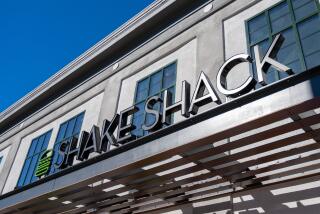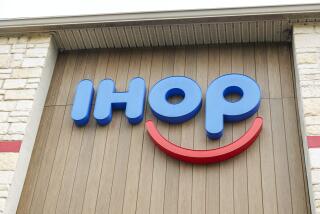IHOP orders up Applebee’s
IHOP Corp. is betting $2.1 billion that it’s got the recipe to get Applebee’s restaurants cooking again: Own less, franchise more.
The Glendale-based restaurant chain famous for its pancakes agreed Monday to acquire the much bigger Applebee’s International Inc., whose casual restaurants cater to the lunch-and-dinner crowd.
Applebee’s has been struggling with declining profit as many of its customers cut their spending to grapple with higher gasoline prices and mortgage payments, industry experts say.
IHOP executives believe that they can perk things up by selling most of Applebee’s 508 corporate-owned restaurants to franchisees.
That strategy cuts overhead costs while shifting more risk to owner-operators and away from the parent company, said IHOP Chief Executive Julia Stewart, who ran Applebee’s domestic operations from 1998 to 2001.
It also enables individual restaurants to respond quickly to changing trends and tastes in their markets, she said.
Franchisees “are savvy. They are local. They know their markets and their customers,” Stewart said. “We want to tap into that entrepreneurial spirit. We did it successfully at IHOP and we will do it again at Applebee’s.”
Applebee’s, headquartered in Overland Park, Kan., currently franchises about three-quarters of its 1,900 restaurants worldwide. In contrast, 99% of IHOP’s approximately 1,300 eateries are operated by franchisees.
Casual-dining restaurants such as Applebee’s, Chili’s and TGI Friday’s are particularly vulnerable to economic soft patches.
“The guy who enjoys his steak at Morton’s is still going to enjoy his steak at Morton’s and gas prices are not going to be an issue,” said Darren Tristano, an executive vice president at Technomic Inc., a food industry consulting and research firm.
“But casual diners, mainstream Americans, they are going to downgrade to a place ... where you might pay $7 or $10 for a meal and you don’t have to tip,” he said.
Family-style restaurants such as IHOP are vulnerable to a slowing economy as well, but the company posted record profit of $44.6 million last year thanks in part to its increased reliance on franchising. Profit at Applebee’s has fallen for the last two years, to $80.9 million in 2006.
There are more than 30 Applebee’s and 120 IHOP restaurants in Southern California.
Applebee’s has a market value of about $2 billion, double that of IHOP. Its restaurants sell more than twice the dollar amount of food, $4.5 billion last year, compared with IHOP’s $2.1 billion in sales.
On Monday, IHOP said it was offering $25.50 a share in cash for Applebee’s, or $1.9 billion, and assuming about $200 million of Applebee’s debt.
The news sent both stocks higher Monday, with IHOP up $4.99 at $61.24 and Applebee’s adding 53 cents to $24.91.
Typically in an acquisition, shares of the target company rise while the acquiring company’s shares fall. That’s because the deal creates demand for shares of the target company, while diluting the value of the acquiring company’s shares.
Industry observers said the jump in IHOP’s shares was a sign the company was getting the equivalent of a breakfast special.
“They didn’t overpay,” said Victor Hawley, a principal at West Los Angeles-based Reed Conner & Birdwell Investment Management, which holds just under 400,000 IHOP shares. “The businesses complement each other, you’ve got breakfast and now more of dinner business.”
The offer was significantly lower than Applebee’s 52-week high stock price of $28.59 reached May 8, but it gives shareholders a premium of 4.6% over Friday’s closing price.
The acquisition is likely to be completed in three months if it is approved, as expected, by shareholders and regulators.
Stewart said IHOP wouldn’t consider any new stores until it pared down the number of corporate-owned sites to less than 5%. The move would save close to $50 million in general and administrative costs over the next three years, she said. The company plans to keep 40 to 50 stores to test new menus, restaurant designs and other initiatives.
Despite investor bullishness over the deal, Bob Goldin, another executive vice president at consultant Technomic, voiced caution.
“When you get down to it, most successful companies in this industry are focused on a core brand,” Goldin said.
“IHOP has been a real solid performer and Applebee’s has been hit with some stumbling blocks,” he said. “It is going to require a lot of management’s attention and time to fix it and I am afraid they may take their nose off the wheel.... Things are a bargain for a reason.”
--
(BEGIN TEXT OF INFOBOX)
Company resumes
IHOP Corp.
Headquarters: Glendale
Restaurants: 1,306 in 49 states, the U.S. Virgin Islands, Canada and Mexico
Employees: 70,000
The concept: Family-style eatery with signature breakfast fare, including fruit-topped pancakes, served any time of day. The first International House of Pancakes opened in Toluca Lake in 1958.
Applebee’s International Inc.
Headquarters: Overland Park, Kan.
Restaurants: More than 1,900 in 49 states, one U.S. territory and 16 countries
Employees: 100,000
The concept: Casual dining under the trademark Applebee’s Neighborhood Grill & Bar. Founded in 1983, the restaurants offer a wide menu of traditional American fare including steaks and hamburgers.
--
Sources: The companies
More to Read
Inside the business of entertainment
The Wide Shot brings you news, analysis and insights on everything from streaming wars to production — and what it all means for the future.
You may occasionally receive promotional content from the Los Angeles Times.










